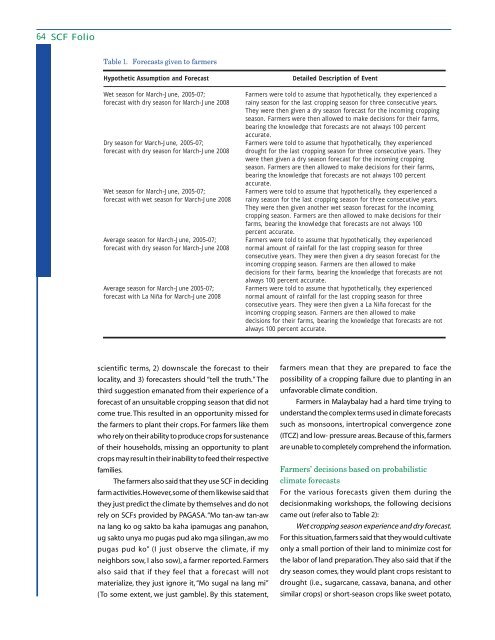Read More - Philippine Institute for Development Studies
Read More - Philippine Institute for Development Studies
Read More - Philippine Institute for Development Studies
Create successful ePaper yourself
Turn your PDF publications into a flip-book with our unique Google optimized e-Paper software.
64 SCF Folio<br />
Table 1. Forecasts given to farmers<br />
Hypothetic Assumption and Forecast<br />
Wet season <strong>for</strong> March–June, 2005–07;<br />
<strong>for</strong>ecast with dry season <strong>for</strong> March-June 2008<br />
Dry season <strong>for</strong> March–June, 2005–07;<br />
<strong>for</strong>ecast with dry season <strong>for</strong> March–June 2008<br />
Wet season <strong>for</strong> March–June, 2005–07;<br />
<strong>for</strong>ecast with wet season <strong>for</strong> March–June 2008<br />
Average season <strong>for</strong> March–June, 2005–07;<br />
<strong>for</strong>ecast with dry season <strong>for</strong> March–June 2008<br />
Average season <strong>for</strong> March–June 2005–07;<br />
<strong>for</strong>ecast with La Niña <strong>for</strong> March–June 2008<br />
Detailed Description of Event<br />
Farmers were told to assume that hypothetically, they experienced a<br />
rainy season <strong>for</strong> the last cropping season <strong>for</strong> three consecutive years.<br />
They were then given a dry season <strong>for</strong>ecast <strong>for</strong> the incoming cropping<br />
season. Farmers were then allowed to make decisions <strong>for</strong> their farms,<br />
bearing the knowledge that <strong>for</strong>ecasts are not always 100 percent<br />
accurate.<br />
Farmers were told to assume that hypothetically, they experienced<br />
drought <strong>for</strong> the last cropping season <strong>for</strong> three consecutive years. They<br />
were then given a dry season <strong>for</strong>ecast <strong>for</strong> the incoming cropping<br />
season. Farmers are then allowed to make decisions <strong>for</strong> their farms,<br />
bearing the knowledge that <strong>for</strong>ecasts are not always 100 percent<br />
accurate.<br />
Farmers were told to assume that hypothetically, they experienced a<br />
rainy season <strong>for</strong> the last cropping season <strong>for</strong> three consecutive years.<br />
They were then given another wet season <strong>for</strong>ecast <strong>for</strong> the incoming<br />
cropping season. Farmers are then allowed to make decisions <strong>for</strong> their<br />
farms, bearing the knowledge that <strong>for</strong>ecasts are not always 100<br />
percent accurate.<br />
Farmers were told to assume that hypothetically, they experienced<br />
normal amount of rainfall <strong>for</strong> the last cropping season <strong>for</strong> three<br />
consecutive years. They were then given a dry season <strong>for</strong>ecast <strong>for</strong> the<br />
incoming cropping season. Farmers are then allowed to make<br />
decisions <strong>for</strong> their farms, bearing the knowledge that <strong>for</strong>ecasts are not<br />
always 100 percent accurate.<br />
Farmers were told to assume that hypothetically, they experienced<br />
normal amount of rainfall <strong>for</strong> the last cropping season <strong>for</strong> three<br />
consecutive years. They were then given a La Niña <strong>for</strong>ecast <strong>for</strong> the<br />
incoming cropping season. Farmers are then allowed to make<br />
decisions <strong>for</strong> their farms, bearing the knowledge that <strong>for</strong>ecasts are not<br />
always 100 percent accurate.<br />
scientific terms, 2) downscale the <strong>for</strong>ecast to their<br />
locality, and 3) <strong>for</strong>ecasters should “tell the truth.” The<br />
third suggestion emanated from their experience of a<br />
<strong>for</strong>ecast of an unsuitable cropping season that did not<br />
come true. This resulted in an opportunity missed <strong>for</strong><br />
the farmers to plant their crops. For farmers like them<br />
who rely on their ability to produce crops <strong>for</strong> sustenance<br />
of their households, missing an opportunity to plant<br />
crops may result in their inability to feed their respective<br />
families.<br />
The farmers also said that they use SCF in deciding<br />
farm activities. However, some of them likewise said that<br />
they just predict the climate by themselves and do not<br />
rely on SCFs provided by PAGASA. “Mo tan-aw tan-aw<br />
na lang ko og sakto ba kaha ipamugas ang panahon,<br />
ug sakto unya mo pugas pud ako mga silingan, aw mo<br />
pugas pud ko” (I just observe the climate, if my<br />
neighbors sow, I also sow), a farmer reported. Farmers<br />
also said that if they feel that a <strong>for</strong>ecast will not<br />
materialize, they just ignore it, “Mo sugal na lang mi”<br />
(To some extent, we just gamble). By this statement,<br />
farmers mean that they are prepared to face the<br />
possibility of a cropping failure due to planting in an<br />
unfavorable climate condition.<br />
Farmers in Malaybalay had a hard time trying to<br />
understand the complex terms used in climate <strong>for</strong>ecasts<br />
such as monsoons, intertropical convergence zone<br />
(ITCZ) and low- pressure areas. Because of this, farmers<br />
are unable to completely comprehend the in<strong>for</strong>mation.<br />
Farmers’ decisions based on probabilistic<br />
climate <strong>for</strong>ecasts<br />
For the various <strong>for</strong>ecasts given them during the<br />
decisionmaking workshops, the following decisions<br />
came out (refer also to Table 2):<br />
Wet cropping season experience and dry <strong>for</strong>ecast.<br />
For this situation, farmers said that they would cultivate<br />
only a small portion of their land to minimize cost <strong>for</strong><br />
the labor of land preparation. They also said that if the<br />
dry season comes, they would plant crops resistant to<br />
drought (i.e., sugarcane, cassava, banana, and other<br />
similar crops) or short-season crops like sweet potato,










